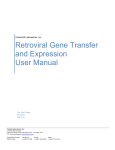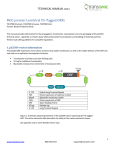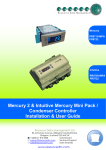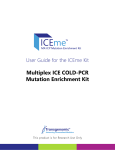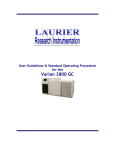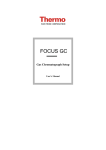Download USER GUIDE FOR CARBOHYDRATE ANALYSIS COLUMNS
Transcript
the power of discovery ® Chromatography Technical and Customer Support Phone: 1-775-829-7689 Email: [email protected] Corporate Headquarters Europe Transgenomic, Inc. 12325 Emmet Street Omaha, NE 68164, USA Phone: (888) 233-WAVE • (402) 452-5400 Fax: (402) 452-5401 Email: [email protected] Transgenomic Limited 40 Watt Road, Hillington Park Glasgow G52 4RY, UK Phone: +44 (0) 141 892 8800 Fax: +44 (0) 141 883 5967 Email: [email protected] www.transgenomic.com “TRANSGENOMIC”, “the power of discovery”, “SURVEYOR”, “WAVE” and the globe logo are registered trademarks of Transgenomic, Inc. All other trademarks are trademarks of their respective owners. ©2008 Transgenomic, Inc. All rights reserved. Printed in USA. Document No. 482214-00 06/08 the power of discovery ® USER GUIDE FOR CARBOHYDRATE ANALYSIS COLUMNS USER GUIDE FOR CARBOHYDRATE ANALYSIS COLUMNS This manual describes the use of following Carbohydrate Columns Product Name Catalog Number Product Name Catalog Number Coregel 87C CHO611OH USP L-19 CHO882 CHO820 CHO620 CHO411 CHO682 Coregel 87C Coregel 87N Coregel 87MM CHO-99-5860 CHO-99-7752 CHO-99-8453 CHO-99-8770 CHO-99-8855 CHO-99-9753 CHO-99-9850 CHO-99-9854 CHO-99-9860 CHO-99-9863 CHO-99-9865 CHO882 CHO782 CHO511 CHO682 CHO611 CHO620 CHO682 CHO820 Coregel 87K Coregel 87P CHO-99-5882 CHO-99-7770 CHO-99-8500 CHO-99-8854 CHO-99-9751 CHO-99-9753W CHO-99-9853 CHO-99-9855 CHO-99-9862 CHO-99-9864 Document Number: 482214-00 1 YOU SHOULD REVIEW THE CONTENTS OF THIS USER GUIDE THOROUGHLY BEFORE INSTALLING YOUR COLUMN IMPROPER USE WILL INVALIDATE THE WARRANTY For additional important information on Carbohydrate Analysis Columns, please use the link below to access our Carbohydrate Application Note on our website: Carbohydrate Analysis HPLC Columns. http://www.transgenomic.com/pd/chrom/Overview.asp WARNING: Transgenomic Carbohydrate Analysis Columns are packed with polymeric materials that require special care. Introduction of ORGANIC SOLVENTS into the column except as described below (see Cleaning and Regeneration Procedures) will INVALIDATE THE WARRANTY. ORGANIC SOLVENTS will swell the polymers which causes increased column pressure. If the column pressure exceeds the maximum recommended limit the warranty is invalidated. The test system must be completely free of organics, metals, particulates or other possible contaminants prior to column installation. Please make sure the test system is thoroughly rinsed with deionized water before installing the column. Refer to your instrument Users’ Manual for instructions on cleaning your test system. Document Number: 482214-00 2 Table of Contents Section 1: Introduction………………………………………………………….. 4 Section 2: Column Installation Procedures…………………………….….…. 4-8 2.1 Column Inspection…………………………………………….……. 2.2 Mobile Phase Preparation…………………………………….…… 2.3 Flow Rate and Temperature…………………………………….… Table 1: Recommended Test Conditions…………………………….. 2.4 Column Installation…………………………………………………. 2.5 Column Shut Down and Storage…………………………………. 4 5 5 5 7 8 Section 3: Guard Columns…………………………………………………..…. 8-9 3.1 Guard Column Overview…………………………………………… 8 3.2 Guard Column Installation…….………………………………….... 8 3.3 Guard Column Replacement…………………………………….… 9 Section 4: Samples……………………………………………………………… 9-10 4.1 Sample Preparation………………………………………………... 9 4.2 Sample Volume and Concentration………………………………. 9 Section 5: Detection and Sensitivity…………………………………………… 10 Section 6: Column Storage……………………………………………………... 10 Section 7: Troubleshooting……………………………………………………… 10-12 7.1 Problem: High Back Pressure…………..…………………..……… 10 7.2 Problem: Decrease in Column Performance…………………...… 11 Section 8: Regeneration and Cleaning Procedures……………………..…… 13-15 8.1 Expanding the Resin Bed……………………………………….….. 13 8.2 Cleaning a Contaminated Column……………………………….... 13 8.3 First Cleaning Procedure……………………………………….…... 13 8.4 Second Cleaning Procedure………………………………….……. 14 Table 2: Regeneration Solutions………………………….……….…… 14 8.5 Third Cleaning Procedure…………………………..………….…… 15 8.6 Fourth Cleaning Procedure…………………….……………….….. 15 Section 9: Column Warranty……………………………………………………. 15 Section 10: Customer Service & Contact Details…………………………..… 16 Section 11: Trademarks & Copyright………………………………………...… 16 Document Number: 482214-00 3 SECTION 1: INTRODUCTION Ligand exchange is the preferred method for the separation of many sugars and sugar alcohols due to the use of a simple water mobile phase. In ligand exchange, the negatively-charged hydroxyl groups on the carbohydrate molecules interact with the positively-charged, metal-loaded groups on the chromatography substrates. The carbohydrates are eluted by the polar water eluent which competes for the sites on the metal ion. Besides the ligand exchange mechanism, several secondary mechanisms’ processes are also involved in the separation of the carbohydrates including size exclusion and normal phase partitioning. HPLC columns packed with low cross-linked polymers (gels) serve as the primary packing material for carbohydrate analysis columns. In order to maximize the separation of a wide variety of samples, Transgenomic has developed the most complete line of carbohydrate analysis columns available on the market by combining ligand exchange (metals), size exclusion and partitioning (cross-linkage of polymer), particle size (column efficiency) and column size (speed versus resolution). In general, polymeric gels are resistant to chemical degradation; therefore if treated correctly, the columns will last for many injections. However, compared to other typical chromatographic media such as silica or highly cross-linked polymers, polymeric gels are more susceptible to failure due to excessive operating back pressures. Pump flow rates and column oven temperatures must be carefully maintained and monitored to ensure that the column is operated below the recommended pressure maximum. Also polymeric gels are not compatible with solvents except under the strict conditions outlined in the Regeneration and Cleaning Procedures (Section 8). The small pore sizes in gels make the packed column bed an excellent depth filter. Therefore it is highly recommended that the mobile phases are passed through a filtering system which can be either off-line or by using in-bottle filters or in-line filters with a porosity of 0.45 micrometers or smaller. SECTION 2: COLUMN INSTALLATION PROCEDURES 2.1 Column Inspection Carefully unpack the column from the shipping box. Although columns are very resilient to shock, it is possible for the polymer bed to crack if it is dropped on a hard surface. Examine the column for any signs of damage that may have occurred during shipping. Please notify the carrier of any damage and contact Transgenomic Customer Service (see Section 10 of this manual). It is advisable to save the column box for storage when the column is not in use. Document Number: 482214-00 4 2.2 Mobile Phase Preparation The only recommended mobile phase is degassed, de-ionized water. The water must be free of metal ions and halides, bacteria and particulates (filtered through 0.45 micron membrane). The minimum recommended purity is 18 MΩ. HPLC grade water meeting the minimum purity requirements is available commercially. The only exception is the use of dilute sodium hydroxide mobile phases for the CHO611OH column, which is prepared using high purity sodium hydroxide (99% purity). The mobile phase should be degassed using one of the following methods: vacuum, ultrasonics, helium sparging or boiling. If practical the flask used to degas the water should also be used as the solvent reservoir, as the pouring of degassed water into another flask can introduce air into the flask. If using vacuum degassing, it is advisable to add a stirring bar to the flask to facilitate the release of gas. The water should be degassed for at least 30 minutes before use. Boiling is an extremely effective way to degas your solution. The water should be boiled for at least 15 minutes once it reaches the boiling point. Care should be taken when pouring the boiled water into the solvent reservoir. Fresh mobile phase should be prepared every 24 hours. Improper degassing will result in air bubbles (especially at high column temperatures) that may result in an unstable baseline. If “spikes” or “noise” are observed on the chromatographic trace, stop the pump and degas the solvent. Purging of the flow cell may be required to remove trapped air bubbles. Please refer to your detector user guide for instructions. 2.3 Flow Rate and Temperature The column back pressure is a result of the combination of flow rate and temperature. It is extremely important to use a flow rate and temperature that keeps the pressure below the recommended maximum pressure. In general, if you increase the temperature, the flow rate may also be increased (do not exceed maximum recommended flow rate) and still safely operate below the maximum recommended pressure for the column. Since temperature is the key factor in changing the selectivity of your column for certain compounds, it is important to remember if you decrease the temperature to enhance a separation, you may also need to decrease the flow rate. Table 1 (Page 6) shows the recommended operating conditions for the carbohydrate analysis columns. Document Number: 482214-00 5 TABLE 1 Recommended Test Conditions for Carbohydrate Analysis Columns Column Type Part Number Maximum Pressure (PSI) Standard Flow Rate (mL/min) Maximum Flow Rate (mL/min) Standard Temperature (ºC) Maximum Temperature (ºC) Coregel 87C (Fast) CHO-99-5860 1000 0.6 1.0 85 95 CHO882 (Fast) CHO-99-5882 800 0.5 0.8 80 95 CHO611OH CHO-99-7752 1000 0.5 1.0 90 90 CHO782 CHO-99-7770 1000 0.5 0.7 70 95 Column Type USP L-19 CHO511 CHO882 CHO682 (Fast) Part Number CHO-99-8453 CHO-99-8500 CHO-99-8770 CHO-99-8854 & CHO-99-9853 Maximum Pressure (PSI) Standard Flow Rate (mL/min) Maximum Flow Rate (mL/min) Standard Temperature (ºC) Maximum Temperature (ºC) 1000 0.2 0.5 30 95 1000 0.4 0.6 85 95 1000 0.5 0.8 80 95 800 0.4 0.6 80 95 Column Type Part Number Maximum Pressure (PSI) Standard Flow Rate (mL/min) Maximum Flow Rate (mL/min) Standard Temperature (ºC) Maximum Temperature (ºC) CHO820 (Fast) CHO-99-8855 800 0.5 1.0 90 95 CHO611 CHO-99-9751 1000 0.5 0.7 90 95 CHO620 CHO-99-9753 1000 0.5 0.7 90 95 CHO620 (Waters) CHO-99-9753W 1000 0.5 0.7 90 95 Column Type Part Number Maximum Pressure (PSI) Standard Flow Rate (mL/min) Maximum Flow Rate (mL/min) Standard Temperature (ºC) Maximum Temperature (ºC) CHO411 CHO-99-9850 800 0.4 0.6 85 95 CHO682 CHO-99-9854 1200 0.4 0.5 80 95 CHO820 CHO-99-9855 1000 0.5 1.0 90 95 Coregel 87C CHO-99-9860 1000 0.6 1.0 85 95 Column Type Part Number Maximum Pressure (PSI) Standard Flow Rate (mL/min) Maximum Flow Rate (mL/min) Standard Temperature Maximum Temperature Coregel 87K CHO-99-9862 1000 0.6 1.0 85 95 Coregel 87N CHO-99-9863 1000 0.6 1.0 85 95 Coregel 87P CHO-99-9864 1000 1.0 1.0 85 95 Coregel 87MM CHO-99-9865 1000 0.6 1.0 85 95 Document Number: 482214-00 6 2.4 Column Installation After determining the correct initial test conditions, remove the end plugs from the column. The end plugs should be saved and tightly inserted in the end fittings when the column is not in use. Connect the column to the inlet fitting on the system. Orient the column according to the flow arrow on the column; the arrow points in the direction of the flow. The column can be operated in either flow direction, but maximum efficiency is achieved by using the arrow as a flow guide. For correct connection the thread must be 10-32 and designed for use with 1/16” OD tubing. Push the tubing all the way into the inlet fitting until it is seated and tighten the fitting. It is recommended that when first installing the column a piece of outlet tubing is connected to the outlet fitting but not to the system. Make sure that you insert other end of outlet tubing into a waste container. Close the oven and allow the column to warm up for 5–10 minutes before starting the pump to avoid over pressuring the column. It is highly recommended that you set the pressure system shut-off at the maximum allowable pressure for the column before starting the pump An alternative start up method is to reduce the initial flow rate setting to half of the recommended flow rate and increase it once the column is fully up to temperature. Start the pump and monitor the pressure. Please note that it is very common when first connecting a polymeric gel column after storage that a small amount of yellow liquid elutes from the column. This material is a polysulfonate formed during column storage which is not harmful to the column or test system, and will clear from the column after a couple of minutes. The pressure should gradually increase after starting the flow but remain lower than the maximum recommended pressure. As the column becomes fully heated you will see a drop in pressure. Once the pressure stabilizes compare the pressure to the pressure recorded on the chromatogram sent with the column. Although there will be some system to system differences, the pressure should be approximately the same as the one recorded on the chromatogram assuming the same flow rate and temperature conditions are used. After 30 minutes, connect the outlet fitting from the system to the outlet end fitting. Warning: The column will be hot and you should use heat-insulated gloves The pressure should be approximately the same as before connecting the outlet end fitting, although detectors will typically add a small amount of pressure to the system. If the pressure is below the maximum limit, and the baseline is stable, the column is ready for testing. It may take a few minutes for the baseline to stabilize after the connection of the outlet end fitting. Please refer to the Troubleshooting Section (Pages 10–12) in this User Guide if you are experiencing any pressure or baseline problems. HINT: Excessive dead volume in the system can significantly decrease column efficiency and compromise your separation due to band broadening. The tubing length between the outlet of the column and detector should be as short as possible. The recommended internal diameter of the tubing is 0.010 inches. Small diameter tubing should be used between the column and the detector as well as between the injector and column (or guard column). Document Number: 482214-00 7 2.5 Column Shut Down and Storage To shut down a column correctly turn off the column oven and pump. Allow the column to reach ambient temperature before removing it from the system. To speed up the column reaching ambient temperature, leave the oven compartment open if possible. Tightly insert the end plugs that came with the column and place the column in the storage box. The only recommended storage solution is the mobile phase. Store the column at laboratory temperature since excessive temperature over a long period of time might dry out part of the resin bed. Never leave the column in a heated oven for an extended period of time without mobile phase flowing through the column. To speed up start-up times each day, it is possible to reduce the flow rate to 0.2 mL/min and leave the oven on overnight. Make sure there is enough eluent to last until the next day Briefly turn off the pump the next day and replace the mobile phase with fresh, degassed eluent. Start the pump; increase the flow rate to the desired setting and the column is now ready for testing. SECTION 3: GUARD COLUMNS 3.1 Guard Column Overview Guard columns are an extremely effective method for protecting the analytical column. Because guard columns are packed with the same type of polymers used in the analytical column, contaminants which would foul the polymer in the analytical column will usually be filtered out first by the guard columns. Many types of contaminants such as metals, organics and particulate matter can be prevented from entering the analytical column with the use of a guard column. Transgenomic guard columns are available either in a stainless steel, 50 x 4.6 mm column format or in 20 x 4.0 mm PEEK cartridges with titanium frits that fit into a reusable stainless steel holder. The 50 x 4.6 mm column format is recommended for relatively clean samples and when additional resolution is needed for the separation. The 20 x 4.0 mm cartridges are the most commonly used Transgenomic guard columns when sample preparation is minimal or excluded due to the necessity of maintaining sample integrity. 3.2 Guard Column Installation Guard columns should be installed following the same method as the analytical column. However, the guard column will reach temperature within a couple of minutes and will need to be flushed for only a couple of minutes prior to connecting to the column. The guard column can be connected directly to the column either using the Transgenomic Column Coupler (Part Number 282013) or with 1/16” tubing and 10-32 thread fittings. If possible, insert the guard column into the heater for improved efficiency and lower pressure. It may not be practical to use the direct coupler due to size constraints in some commercial ovens, especially when using the 300 mm length analytical columns. It may be possible to use 1/16” tubing and bend the tubing in order to fit the guard column and column into the oven. If the guard column will not fit into the Document Number: 482214-00 8 oven, use the shortest possible length of tubing (0.010 inch diameter) to connect the guard column outside of the oven to the analytical column. 3.3 Guard Column Replacement The guard column will add approximately 25 psi to 100 psi of pressure to the system, depending on the type and whether it can be installed inside of the oven. Record the pressure of the system with the guard column and analytical column in place. After the initial test, note the efficiency and retention times of the compounds with a fresh guard column installed. Monitor the pressure and chromatographic performance for signs of guard column contamination. If the pressure of the guard column increases 100 psi or there is a loss of column efficiency or change in retention times of more than 5%, it may be time to change the guard column. Replace the guard column and check to see if system performance returns to the previous level. The frequency of changing the guard column depends on the nature of the sample and the level of sample preparation. SECTION 4: SAMPLES 4.1 Sample Preparation Column lifetimes can be extended using sample preparation techniques. You should avoid or minimize introduction of organic materials, particulates, salts, acids (or acidic samples) and heavy metals into the column by either the mobile phase or samples. The type of possible contaminants will determine the sample preparation technique(s). Please review the sample preparation products available from Transgenomic on our website (www.transgenomic.com) in the Chromatography - Solid Phase Extraction section. There are also many companies specializing in sample preparation solutions that may have products specifically designed for your sample needs. If you are unable to use sample preparation to remove potential contaminants, the Transgenomic guard columns will offer universal protection against most types of contamination, although guard column lifetimes may be short. Minimally, all samples should be filtered though a 0.45 micron pore (or smaller) filter prior to injection to remove particulates. It is also recommended that an in-line filter with a minimum porosity of 0.45 micron be used between the injector and column, especially if no guard columns are used. 4.2 Sample Volume and Concentration Transgenomic carbohydrate analysis columns are typically tested using a 20 µL injection volume. The recommended injection volume range is 10–100 µL, but column efficiency and peak resolution is dependent on the concentration of the compounds. Injection volumes greater than 100 µL are possible, but the increased volume may lead to band broadening due to sample overloading, or exceed the limits of the detector. Document Number: 482214-00 9 Carbohydrate standards used by Transgenomic typically range from 1.0–10.0 mg/mL. It is possible to inject amounts greater that 10 mg/mL, but loss of resolution can occur due to exceeding the ligand exchange capacity of the polymer. Monitor the column efficiency versus sample concentration to determine the limits of your particular sample. SECTION 5: DETECTION AND SENSITIVITY A variety of detectors can be used for carbohydrate detection. The simplicity of the water mobile phase and the requirement of only isocratic conditions enable chromatographers to choose from among photometers, refractometers and electrochemical detectors. However, by far the most commonly used instrument for carbohydrate analysis is the dual refractive index detector. All of the Transgenomic Carbohydrate Analysis Columns are tested using refractive index detectors. Because carbohydrates do not absorb ultraviolet light to any measurable extent, the use of ultraviolet (UV) detectors is precluded. For carbohydrates, increased sensitivity can often be achieved by the use of post-column reaction together with a photometric or fluorometric detector. Remember that sensitivity of detection is ultimately determined by the type of detector chosen; the role of the column is simply to separate the compounds of interest. SECTION 6: COLUMN STORAGE The column storage solution is the same purity water as used for testing. The end plugs must be tightly inserted to prevent the column bed from drying out. Place the column in the column shipping box and place in climate controlled environment. The column should not be exposed to temperatures above 24 oC during storage. For prolonged periods of storage (more than one month) it is recommended to store the column in a refrigerator (~4 oC). Do not allow the column to freeze as this can result in a cracked column bed. Allow the column to reach ambient temperature before installing the column on the test system. SECTION 7: TROUBLESHOOTING The following section is intended as an aid in locating sources of performance loss. Because of the nature of polymeric materials and the manufacturing procedures employed by Transgenomic, it is highly unusual for a column to lose performance due to manufacturing problems. In our experience, nearly all early column failures are a result of the introduction of contaminants into the column, or exceeding the maximum recommended pressure for the column. All Transgenomic columns are thoroughly tested prior to shipment and are supplied with a sample chromatogram illustrating performance of the particular column. 7.1 Problem: High Back Pressure Follow the steps below to determine the source of high pressure. If the column pressure returns to the expected range after any of the steps, you may return to normal column testing. Document Number: 482214-00 10 Step 1: Turn off pump. Remove the column and connect a coupler to the inlet and outlet fittings. Turn on the pump and check the system pressure. Isolate the source of the high pressure by checking and replacing the individual components. Refer to the instrument manuals for recommendations on replacing or repairing parts. Step 2: Measure the column oven temperature to make sure that it is operating at the current setting. Ovens operating below the temperature setting will lead to higher pressure. Step 3: Turn off the pump. Remove the analytical column, but leave in place the guard column. Connect the outlet fitting to the guard column and turn on the pump. If the guard column is the source of the high pressure, replace or regenerate the guard column. Step 4: If the high pressure is isolated to the analytical column, please refer to the section on Regeneration and Cleaning Procedures (Pages 13-15). 7.2 Problem: Decrease in Column Performance Decreases in column performance over time are normal due to unavoidable accumulation of chemicals on the functional sites of the polymer, compression or settling of the resin bed due to exposure to a constant flow of solution and changes in selectivity due to hydrophobic interaction of the polymeric backbone to trace organics from solutions or samples introduced to the column. However, if loss of performance occurs prior to the end of the warranty period or after only a minimum number of sample injections, it is almost always caused by excessive column pressure or introduction of contaminants. A decrease in column performance is usually apparent by a loss of efficiency (band broadening or poor peak shape), a change in selectivity (peaks elute at different times relative to other peaks) or changes in retention time. If the loss of column performance prevents you from correctly analyzing your sample, you will need to either regenerate or replace your analytical column. It is important to identify the cause of loss of column performance before installing a new or regenerated column. Possible causes for a loss of column performance due to a decrease in resolution or change in selectivity: (a) Introduction of metals or cations into the column will cause the metal ligand on the polymer to be displaced over time by the metal contaminant or cation. Because different types of ligands interact selectively with carbohydrates, when the intended ligand is displaced by another metal or cation, the selectivity of the column will be altered and the resin bed can be irreversibly disturbed. Changes in selectivity can also affect the resolution of peaks as carbohydrates can have a relatively different interaction with the ligand resulting in a shift in peak patterns. Possible sources of metals or cations include the mobile phase, test system components and the sample. (b) Organic materials may bind to the hydrophobic polymeric core and change the way the polymer interacts with the sample. Possible sources of organics include the mobile phase, test system components and the sample. Document Number: 482214-00 11 (c) An increase or decrease in temperature can result in loss of resolution or change in selectivity between compounds as they elute at different times relative to each other. Check to make sure the oven is operating correctly. (d) Compression of the column polymer bed will result in loss of resolution due to peak broadening and poor peak shape. Frequently retention times remain constant. Bed compression is usually due to excessive pressure. (e) Test system component failure due to malfunctioning parts or contamination can result in loss of resolution. Possible causes for a loss of column performance due to a decrease in retention time: (a) Introduction of metals or cations into the column will cause the metal ligand on the polymer to be displaced over time by the metal contaminant or cation. Smaller cations such as hydrogen can displace metals that have a stronger interaction with carbohydrates and reduce retention times. Possible sources of metals or cations include the mobile phase, test system components and the sample. (b) Organic materials may bind to the hydrophobic polymeric core and change the capacity of the column. Possible sources of organics include the mobile phase, test system components and the sample. (c) An increase in temperature can result in decreased retention. Check to make sure the oven is operating correctly. (d) If a channel forms in the resin bed, there can be a decrease in retention. Bed channeling will also result in decreased column efficiency and poor peak shape. (e) Increased flow rates will result in decreased retention time. Check to make sure the pump is operating correctly and that the programmed method has not changed. Possible causes a loss of column performance due to an increase in retention time: (a) Introduction of metals into the column will cause the metal ligand on the polymer to be displaced over time by the metal contaminant. Heavier metals such as lead or iron that bind to the polymer bed can interact strongly with carbohydrates and increase retention times. Possible sources of metals include the mobile phase, test system components and the sample. (b) Organic materials may bind to the hydrophobic polymeric core and change the capacity of the column. Possible sources of organics include the mobile phase, test system components and the sample. (c) A decrease in temperature can result in increased retention. Check to make sure the oven is operating correctly. (d) Decreased flow rates will result in increased retention time. Check to make sure the pump is operating correctly or that the programmed method has not changed. Document Number: 482214-00 12 SECTION 8: REGENERATION AND CLEANING PROCEDURES 8.1: Expanding the Resin Bed The first step in treating a column that has high pressure or loss of resolution due to bed compression is to try to expand the resin bed back to its original position. This step may also remove any possible particulates that may be trapped in the inlet end of the column end fitting which can also lead to high pressure. 1. Turn off the pump and let the column bed relax for 5 minutes. 2. Reverse the flow direction of the column. Do not connect the outlet side to the system in case of particulates. Connect the outlet end with the appropriate tubing and let the solution feed into a waste container. 3. Make sure that the pressure maximum on the system is set to the recommended pressure maximum for the column and that the column has warmed up to temperature before starting the pump. 4. Start the flow rate at 0.1 mL/minute using the normal mobile phase and temperature for the column. Monitor the pressure to make sure it is below the maximum limit. Leave the flow on for at 2 hours. If the pressure drops over this time, you may have removed some particulates or contaminants. 5. Return the column to the original flow direction. Start the flow at 0.1 mL/minute and gradually increase to the normal operating flow rate as long as the column pressure remains below the recommended maximum limit. 6. Test the column to see if performance has been restored. If it is not restored, proceed to the next section. 8.2 Cleaning a Contaminated Column Cleaning a contaminated polymeric gel column is problematic due to the material’s low cross-linkage. The low cross-linkage limits the types of solvent that can be used to clean the polymer due to swelling and interaction with the hydrophobic polymeric backbone. The only solvent recommended for cleaning possible organic contamination is acetonitrile in low concentrations. Acetonitrile is a smaller, lower molecular weight organic solvent that minimizes the swelling of the polymers. However, even with acetonitrile, it should only be used after all other attempts to clean the polymer have been tried and only if organic contamination is suspected. The best way to prevent organic contamination is the frequent use of guard cartridges and by selection of a suitable sample preparation method. 8.3 First Cleaning Procedure The first attempt at cleaning a column is to simply flush the column in the inverted position for an extended period of time with mobile phase at high temperature. Do not connect the outlet end to the system, but allow the solution to flow through the appropriate tubing into a waste container. Set the column oven at 80 ºC–90 ºC (if the column oven does not go up to 80 ºC use the maximum oven temperature) and pump mobile phase through the column for a minimum of 4 hours (or simply overnight). Use the standard flow rate if pressure is normal or adjust the flow rate down to keep within the maximum pressure recommendation. Return the column to the original flow direction Document Number: 482214-00 13 and test conditions and check column performance. If the performance is not fully or partially restored, proceed to the Second Cleaning Procedure. 8.4 Second Cleaning Procedure The composition of the Regeneration Solution depends on the metal ligand used in the column (see Table 2 below). Flush the column using the same method as above (First Cleaning Procedure) but substitute the normal mobile phase with the Regeneration Solution. Adjust the flow rate to 0.2 mL/minute. If the column pressure exceeds the maximum pressure limit, adjust the flow rate to 0.1 mL/minute. Do not connect the outlet tubing to the system, but allow the solution to flow directly into a water container from the column. After the Regeneration Solution wash, flush the column with water in the inverse flow direction at 0.2 mL/minute for 4 hours. Properly dispose of the waste solution after this step. Return the column to the normal flow direction, flow rate and temperature and test the column after equilibrating the column for 30 minutes. If the column performance is not fully or partially restored proceed to the Third Cleaning Procedure. TABLE 2: REGENERATION SOLUTIONS -------------------------------------------------------------------------------------------------------------------Calcium Form Columns: 0.1 M Calcium Acetate plus 0.25 g/L of Calcium-Disodium EDTA Use for only the following columns: Coregel 87C (CHO-99-5860), USP L-19 (CHO-998453), CHO820 (CHO-99-8855), CHO620 (CHO-99-9753), CHO620 (CHO-99-9753W), CHO820 (CHO-99-9855), Coregel 87C (CHO-99-9860) -------------------------------------------------------------------------------------------------------------------Lead Form Columns: 0.1 M Lead Nitrate plus 0.25 g/L of Disodium Dihydrate EDTA Use for only the following columns: CHO882 (CHO-99-5882), CHO782 (CHO-99-7770), CHO882 (CHO-99-8770), CHO682 (CHO-99-8854), CHO682 (CHO-99-9853), CHO682 (CHO-99-9854), Coregel 87P (CHO-99-9864) -------------------------------------------------------------------------------------------------------------------Sodium Form Columns: 0.02 M Disodium Phosphate (Na2HPO4) plus 0.25 g/L of Disodium Dihydrate EDTA Use for only the following columns: CHO611OH (CHO-99-7752), CHO511 (CHO-998500), CHO611 (CHO-99-9751), CHO411 (CHO-99-9850), Coregel 87N (CHO-99-9863) ------------------------------------------------------------------------------------------------------------------Potassium Form Columns: 0.02 M Disodium Phosphate (Na2HPO4) Use for only the following column: Coregel 87K (CHO-99-9862) ------------------------------------------------------------------------------------------------------------------Calcium-Sodium Form Mixed Mode Column: 0.05 M Calcium Acetate plus 0.25 g/L of Calcium-Disodium EDTA Use for only the following column: Coregel 87MM (CHO-99-9865) ------------------------------------------------------------------------------------------------------------------- Document Number: 482214-00 14 8.6 Third Cleaning Procedure Flush the column using the same method as in the Second Cleaning Procedure; however substitute a 10% (v/v) acetonitrile solution for the normal mobile phase. Before testing for column performance flush the column with the normal mobile phase for two hours after the acetonitrile wash. If column performance is partially restored, you may either increase the time of the flush procedure or increase the acetonitrile solution concentration by increments of 10% (v/v). Do not exceed a concentration of 30% (v/v) acetonitrile. 8.7 Fourth Cleaning Procedure Repeat the Regeneration Solution (Second Cleaning Procedure) wash after the acetonitrile wash. SECTION 9 COLUMN WARRANTY Transgenomic carbohydrate analysis columns are under warranty for 30 days from time of installation. The warranty is invalidated by improper usage as detailed by this user guide. If you believe the column has failed prior to the completion of the warranty period due to a manufacturing defect, please contact Transgenomic immediately for instructions on how to return a defective column. The cleaning and regeneration procedures detailed above are designed to extend column lifetime due to normal use or contamination. If the cleaning and regeneration procedures do not restore column performance, please contact Transgenomic Customer Service for further assistance. Please be prepared to discuss the steps taken to restore column performance, the serial number of the column, type of samples, and a detailed description or chromatograms illustrating the problems with the separation. Document Number: 482214-00 15 SECTION 10: CUSTOMER SERVICE & CONTACT DETAILS Main Technical and Customer Support Phone: +1 (775) 829-7689 General Technical and Customer Support Phone: (888) 233-9283 (US only) Main Technical and Customer Support Email: [email protected] Website Technical Support: http://www.transgenomic.com/sp/SupportRequest.asp Head Office: Transgenomic, Inc. 12325 Emmet Street Omaha, NE 68164 United States of America Phone; (888) 233-WAVE (US only); +1 (402) 452-5400 Fax: +1-(402) 452-5401 Email: [email protected] SECTION 11: TRADEMARKS & COPYRIGHT “TRANSGENOMIC,” the globe logo and “the power of discovery” are registered trademarks of Transgenomic, Inc. All other trademarks are trademarks of their respective owners. ©2008 Transgenomic, Inc. All rights reserved. Document Number: 482214-00 16 the power of discovery ® the power of discovery www.transgenomic.com Document No. 482214-00 06/08 ® USER GUIDE FOR CARBOHYDRATE ANALYSIS COLUMNS



















